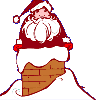 'Twas the Night Before Christmas
'Twas the Night Before Christmas
(or A Visit from St. Nicholas)
by Clement Clarke Moore
'Twas the night before Christmas, when all through the house
not a creature was stirring, not even a mouse.
The stockings were hung by the chimney with care,
in hopes that St. Nicholas soon would be there.
The children were nestled all snug in their beds,
while visions of sugar plums danced in their heads.
And Mama in her 'kerchief, and I in my cap,
had just settled our brains for a long winter's nap.
When out on the roof there arose such a clatter,
I sprang from my bed to see what was the matter.
Away to the window I flew like a flash,
tore open the shutter, and threw up the sash.
The moon on the breast of the new-fallen snow
gave the lustre of midday to objects below,
when, what to my wondering eyes should appear,
but a miniature sleigh and eight tiny reindeer.
With a little old driver, so lively and quick,
I knew in a moment it must be St. Nick.
More rapid than eagles, his coursers they came,
and he whistled and shouted and called them by name:
"Now Dasher! Now Dancer!
Now, Prancer and Vixen!
On, Comet! On, Cupid!
On, Donner and Blitzen!
To the top of the porch!
To the top of the wall!
Now dash away! Dash away!
Dash away all!"
As dry leaves that before the wild hurricane fly,
when they meet with an obstacle, mount to the sky
so up to the house-top the coursers they flew,
with the sleigh full of toys, and St. Nicholas too.
And then, in a twinkling, I heard on the roof
the prancing and pawing of each little hoof.
As I drew in my head and was turning around,
down the chimney St. Nicholas came with a bound.
He was dressed all in fur, from his head to his foot,
and his clothes were all tarnished with ashes and soot.
A bundle of toys he had flung on his back,
and he looked like a peddler just opening his pack.
His eyes--how they twinkled! His dimples, how merry!
His cheeks were like roses, his nose like a cherry!
His droll little mouth was drawn up like a bow,
and the beard on his chin was as white as the snow.
The stump of a pipe he held tight in his teeth,
and the smoke it encircled his head like a wreath.
He had a broad face and a little round belly,
that shook when he laughed, like a bowl full of jelly.
He was chubby and plump, a right jolly old elf,
and I laughed when I saw him, in spite of myself.
A wink of his eye and a twist of his head
soon gave me to know I had nothing to dread.
He spoke not a word, but went straight to his work,
and filled all the stockings, then turned with a jerk.
And laying his finger aside of his nose,
and giving a nod, up the chimney he rose.
He sprang to his sleigh, to his team gave a whistle,
And away they all flew like the down of a thistle.
But I heard him exclaim, 'ere he drove out of sight,
"Happy Christmas to all, and to all a good night!"
A Brief Note about the Author and the Poem |
Clement Clarke Moore's famous poem, which he named "A Visit From St. Nicholas," was published for the first time on December 23, 1823 by a New York newspaper, the Sentinel. Since then, the poem has been reprinted, translated into innumerable languages and circulated throughout the world.
Clement Clarke Moore was born in 1779 to a well-known New York family. His father, Reverend Benjamin Moore, was president of (what is now) Columbia University and was the Episcopal Bishop of New York. Moore's father also participated in George Washington's first inauguration and gave last rites to Alexander Hamilton after Hamilton was mortally wounded in an 1804 duel with Aaron Burr. Moore himself was an author, a noted Hebrew scholar, spoke five languages, and was an early real-estate owner and developer in Manhattan.
Despite his accomplishments, Clement Clarke Moore is remembered only for "'Twas the Night Before Christmas," which legend says he wrote on Christmas Eve in 1822 during a sleigh ride home from Greenwich Village after buying a turkey for his family. Some say the inspiration for Moore's pot-bellied St. Nicholas was the chubby, bewhiskered Dutchman who drove Moore to Greenwich Village to buy his holiday turkey. Moore never copyrighted his poem, and only claimed as his own over a decade after it was first made public. |